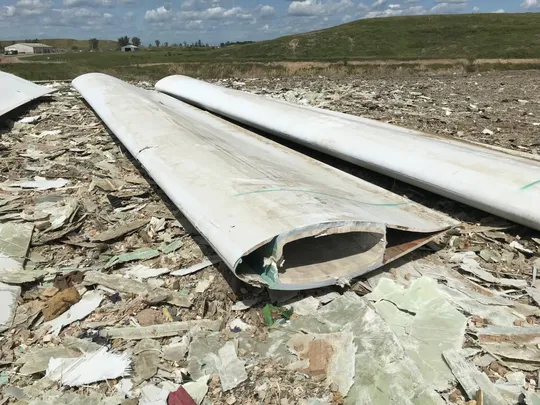Argus Leader: Sioux Falls Landfill Tightens Rules After Minnesota Dumps Dozens of Wind Turbine Blades
American Experiment has been a leader in exposing the fact that wind turbines only last for twenty years, and after that time the turbines must be torn down as part of the decommissioning process. We have also detailed how wind turbine blades cannot be recycled, and must be stored in landfills.
Now, the Argus Leader reports that more than 100 wind turbine blades measuring 120 ft long have been dumped in a Sioux Falls, South Dakota, landfill, but there’s a problem: the massive blades are taking up too much room, according to local City officials. The Argus Leader article reads:
“A wind farm near Albert Lea, Minn., brought dozens of their old turbine blades to the Sioux Falls dump this summer.
But City Hall says it won’t take anymore unless owners take more steps to make the massive fiberglass pieces less space consuming.
The wind energy industry isn’t immune to cyclical replacement, with turbine blades needing to be replaced after a decade or two in use. That has wind energy producers looking for places to accept the blades on their turbines that need to be replaced.
For at least one wind-farm in south central Minnesota, its found the Sioux Falls Regional Sanitary Landfill to be a suitable facility to take its aged-out turbine blades.”
This year, 101 turbine blades have been trucked to the city dump. But with each one spanning 120 feet long, that’s caused officials with the landfill and the Sioux Falls Public Works Department to study the long-term effect that type of refuse could have on the dump.
South Dakota is a long way to travel to dispose of wind turbine blades, which uses a lot of diesel fuel, and South Dakota officials aren’t sure why the blades are making their way to the Mount Rushmore State.
“Public Works Director Mark Cotter couldn’t say why a Minnesota wind farm is choosing to truck its blades to Sioux Falls, whether it’s rates or regulatory climate. But he told the Argus Leader Tuesday the blades accepted to date have come in three pieces, but they still require a lot of labor to get them ready to be placed in the ground.
The out-of-region rate is $64 a ton, and a typical blade weighs between 14 and 19 tons.
That’s because a portion of each blade is hollow on the inside, requiring landfill crews to compact them by crushing them beneath the weight of 120,000-pound trucks.”
Have you ever wondered what the gas mileage is for a 60 ton truck? I hadn’t until I read this article, so I did a little research. It turns out that 60 ton trucks get a whopping 4.4 to 6.6 miles per gallon, which is actually more than I would have estimated. The need to crush the wind turbines greatly increases the difficulty, cost, and carbon footprint of disposing of the blades.
Still, it’s a process that hasn’t proven cost effective, even though the out-of-region price for bringing waste to the landfill is nearly double what locals pay.
“We can’t take any more unless they process them before bringing them to us,” Cotter said. “We’re using too many resources unloading them, driving over them a couple times and working them into the ground.”
Wind energy companies considering Sioux Falls for their old blades will now be required to break them down into pieces no larger than three feet in length. Cotter said that can be done through a grinding or sheering process.
However, Cotter said a few blades accepted at the site to date have been set aside in order to be used in a pilot to determine feasibility for sheering blades on site, the impact on air space at the landfill and if pricing for accepting them should be changed.
“You have to do a certain amount of handling them to understand what your costs are so we can make those decisions,” he said.
The fact that it is too expensive to dispose of wind turbine blades in a landfill should be front page news, because we’re going to have thousands of blades to get rid of in the near future. In fact, the Energy Information Administration shows Minnesota has some of the oldest wind turbines in the country, meaning this problem will present itself sooner than later.

